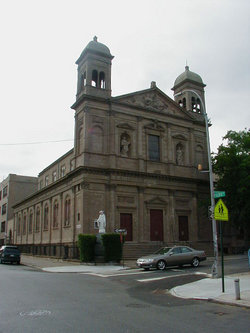St. Marcus's Church (Dunell Hills)
| St. Marcus's Church Ruined for some time, dark. AndyMatthews (talk) 06:38, 28 January 2025 (UTC)
|
| St. Marcus's Church
Dunell Hills [6,33]
Basic Info:
|
There are three locations named St. Marcus's Church in the city of Malton. This article is about the one in Dunell Hills.
St. Marcus's Church [6, 33] is located in the northeastern section of Dunell Hills.
Description
Inside
You are inside St Marcus's Church.
Outside
You are standing outside St Marcus's Church, a small concrete building, its windows missing and broken. Through the broken stained-glass windows, you can see that the interior of the building has been ruined.
Barricading Policy
The DHPD Barricading Policy provides that this building should not be barricaded, whether the suburb is in normal or Lock-Down condition.
Tactical Resource Points
The nearest of each type of tactical resource point to St. Marcus's Church:
- Nearest Hospital is 2 blocks away - Stephen General Hospital at [4, 32].
- Nearest Mall is 13 blocks away - Caiger Mall at [19, 28].
- Nearest NecroTech Building is 3 blocks away - The Dury Building at [5, 36].
- Nearest Police Department is 2 blocks away - Yea Drive Police Department at [8, 32].
History and Significance
St. Mark the Evangelist
Only one of the thirteen saints called Mark is frequently referred to as Saint Marcus: the fourth-century Pope Saint Marcus, known for building the Basilica of San Marco in Rome and for issuing an edict granting the Bishop of Ostia the power to consecrate a newly elected pope. In Malton, however, as in other locales, the common practice is to Latinize the name of a saint when naming a specific location, even when the saint is more commonly referred to by a Hebrew or Anglicized name. An examination of the early history of this particular church indicates that its founders intended that it be named for Saint Mark the Evangelist, companion of Saint Paul and author of the earliest canonical Gospel.
Mark is believed to be the young man referenced in his own Gospel who fled naked from Gethsemane when Christ was arrested (Mark 14:51-52). Some have suggested that Mark was one of the servants who poured out the water that Jesus turned to wine (John 2:1-11), the servant who carried water to the place of the Last Supper (Mark 14:13), one of the seventy-two sent out by Christ (Luke 10:1-24), and the man in whose house the resurrected Christ appeared to the Twelve (John 20:19-29), but none of these claims can be confirmed scripturally.
What is likely is that Mark is the same man known variously in the New Testament as John Mark (Acts 12:12, 25; Acts 15:37), John (Acts 13:5, 13), and Mark (Acts 15:39), and is the same Mark referenced by both St. Paul (Colossians 4:10; 2 Timothy 4:11; Philemon 1:24) and St. Peter (1 Peter 5:13). He was a cousin of Barnabas (Colossians 4:10) and was probably the son of Peter's friend Mary (Acts 12:12), an important figure in the very early Church in Jerusalem. Barnabas and Mark accompanied Paul on his first apostolic journey in approximately 46 CE, and Mark may have helped to minister even though he had not then been called by God (Acts 13:2-4). When Paul decided to journey on to central Asia Minor, Mark returned to Jerusalem instead; for this reason, Paul later determined not to allow Mark to accompany him on his second journey, and this refusal led to the split between Paul and Barnabas (Acts 15:36-40).
Mark does not appear in the New Testament again for some ten years (c. 50-60 CE); it is believed that during that period Mark established the Coptic Orthodox Church in Alexandria, appointing Anianus as bishop, and founded a Christian school there. During Paul's first imprsonment in Rome (59-61 CE), the Apostle wrote that Mark was currently with him and by Peter's side in Rome (Colossians 4:10). It may have been during this period that Mark composed his Gospel; tradition holds that the Roman Christians implored Mark to set down the teachings of Peter, which is reflected in the central position Peter occupies in Mark's Gospel. (In recent decades, however, skeptics have argued that the Gospel was more likely written in 70 CE; if Mark's Gospel was in fact written earlier, then Christ must have correctly predicted the destruction of the Temple of Herod by the Roman general Titus in that year.)
Paul recorded Mark's intent to travel to the churches of Asia Minor (Colossians 4:10) in about 61 CE. Mark almost certainly made this journey, for shortly before his death Paul wrote to Timothy at Ephesus, "Get Mark and bring him [to Rome] with you, because he is helpful to me in my ministry." (2 Timothy 4:11). Further, Peter wrote to various churches in Asia Minor sending greetings from "Mark, my son" (1 Peter 5:13), implying that Mark was by then well known to those churches.
If Timothy did as Paul bade, Mark would have been in Rome when Paul was martyred; soon after, however, Mark returned to Alexandria. He encountered resistance from a vocal faction who resented his attempts to turn the people from their worship of traditional Egyptian deities, and he was martyred on 25 April, 68 CE, at Alexandria. Tradition beginning in the Fourth Century holds that Mark died while being dragged through the streets of Alexandria. Another persistent story is that the Egyptian traditionalists attempted in vain to burn Mark's body; the Alexandrian Christians are said to have retrieved the body from the ashes of the pyre and buried the remains in the church. The body was disinterred and removed to a new basilica in Venice in about 828 CE, but members of the Coptic Church maintain that Mark's head remains in his church in Alexandria.
Mark is usually depicted as a lion or as a man accompanied by a lion. He is a patron saint of notaries and attorneys, for reasons unclear.

